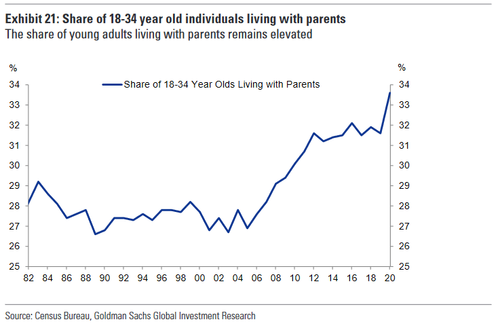China’s Gen Z Splurges On Luxury As Its Debt-To-Income Nears An Insane 2,000%
While representatives of America’s Gen Z are stugling with daytrading dogecoin, finding jobs, and generally leaving their parents’ basement…
… China’s youth is rapidly emerging as the greatest spending power in the world, especially when it comes to buying luxury items they can’t afford.
Take Chinese live-streamer Huang Hanwen who uses domestic cosmetics brands and spends his time talking about animation, comics, games and short novels, as well as domestic, Japanese and Korean celebrities and entertainment news. At weekends, he uses Make Up For Ever and drinks imported whisky mixed with Coke or Red Bull.
Huang – profiled by the SCMP – is 24, putting him in the same demographic as most of his 300,000 fans from across China – Generation Z, which is helping to drive Chinese consumer spending. This generation, born from 1995-2010, buys 15% of all luxury goods sold in China, compared with a worldwide average of 10%. Their expenditures also account for 13% of their total household income, versus just 4% in the US and Britain, according to a survey.

The willingness and desire of young Chinese people to spend their hard-earned income, and that of their families, is also playing an increasingly large role in driving China’s economic development, while outpacing the consumption habits of their peers in the West.
“My fans think I am handsome and look like Japanese and Korean stars,” Huang said. “Young people my age are very concerned about their appearance. I and many of my fans are willing to spend 40% or more of our income on cosmetics, aesthetic medicine and clothing. And we also enjoy spending on whisky, vodka and blind boxes of art toys. We love watching TV series and videos of Chinese ‘ancientry’ style and ACGN. But we rarely talk about politics and the authorities, which are risky to discuss in public.”
Huang became a contracted live-streaming host for a leading video-streaming social platform in China in 2016 when the concept was still in its infancy.
Dressed in ancient clothing traditionally worn by China’s dominant Han ethnicity, Huang sings Chinese pop songs and chats with his fans. He needs to entice 240,000 people a month to watch at least a minute of his live stream so he can earn his base salary.
In addition to the monthly rewards he receives from fans, Huang’s monthly income ranges from 10,000 yuan (US$1,540) to 40,000 yuan.
“My plan is to attract more than 1 million fans on several Chinese live-streaming social media platforms,” he said, adding that he could earn more than 100,000 yuan (US$15,000) per month through advertising and promoting brands online.
Some demographics: the number of Chinese millennials (born between 1980-95) and those from Generation Z has reached 386 million, accounting for 27% of the population. Most do not have siblings, and their peers are more like competitors. Their affinity for the internet is much higher than that of their parents, making them eager for a sense of belonging.
According to China’s “Gen Z White Paper” by Kantar and Tencent, 46% of China’s Generation Z think the goal of consumption is to seek identity recognition, with social, personal style and immediate pleasure seen as their leading motivators. Some 42% of Chinese born in the 1960s are willing to socialize with acquaintances, according to the survey, but the figure is only around 33% among those born in the 2000s, as they take solace in consumption.
“I will spend all of my salary every month, 40% for rent and meals, and 60% for beauty, fitness, travel and clothing. Travel is a must every month,” said Monica Liu, 25, who has an annual income of 250,000 yuan (US$38,500) from her job working in sales for a medical device provider. “I think people around my age are still a generation pursuing designer luxury and will spend a lot of money on European and American brands.
“I come from a middle-class family from Shandong [in northeast China], I shop at Michael Kors and Coach. Friends and colleagues from wealthier families, they shop at Chanel or Gucci. But the younger ones, those born after 2000, may be different from us in spending habits.
“Now, many emerging cosmetics and fashion brands of clothing are domestic brands. For example, many teenagers now like Urban Revivo, which is a local brand in Guangzhou.”
Or take, Yu Mingqian, 21, who lives in Zhumadian, a small city in Henan province, and dreams of spending her money on the gym, travel and imported cosmetics with her friends. Yu borrowed 70,000 yuan from friends and family this year to set up a children’s painting studio, charging each student 3,000 yuan for a year’s course.
“I have already taken a fancy to a Coach bag,” she said. “If the investment goes well, I would like to buy Gucci shoes next year.”
A survey released by OC&C Strategy Consultants showed that of 15,500 young people born in 1998 or later in nine countries – China, the United States, Britain, France, Germany, Italy, Poland, Turkey and Brazil – China’s Generation Z saves less and spends a much higher proportion of their household income than in the Western world.
Expenditures among China’s Generation Z account for 15% of their household income, compared with 4% in France and Germany and 3% in the US and Britain, the survey said.
Although their average monthly disposable income is only around 3,500 yuan, China’s Generation Z spends a lot of their families’ money.
Meanwhile, compared with the generation born in the early stage of China’s reform and opening up, China’s youth have a stronger sense of identity with traditional culture and cultural nationalism, which has driven demand for domestic brands and products that incorporate Chinese traditional style and culture, a trend known as guochao that serves as an emotional outlet for self-expression.
The sales of hanfu, referring to traditional Chinese garments worn by the Han ethnic group before the Qing dynasty in the 1700s, increased from 190 million yuan (US$30 million) in 2015 to 4.52 billion (US$696 million) in 2019, with half bought by China’s Generation Z. The group is generally optimistic about China’s economic development and think property is the most reliable form of wealth in the country.
“I’ve been to several countries in Europe and America for business or leisure. I am optimistic about China’s economic development, especially the performance of China’s economy under the pandemic,” Liu added. “But on the other hand, the mortgage pressure in China’s first-tier cities is too huge. I feel that I will not be happy for a lifetime if I buy one [flat] in Shenzhen. Except for living expenses and mortgage, there is no balance for eating, drinking and playing.”
Of course, at some point the debt hangover will come and it will be horrific.
According to data from the People’s Bank of China at the end of June, the total amount of credit card bills overdue for more than six months had soared to 85.4 billion yuan (US$13 billion), more than 10 times that of 10 years ago. And around half of those who owe the debt were born in the 1990s.
“Many of my friends have several or even up to a dozen credit cards at the same time, and online loans are also very common too.” Yu said.
An HSBC survey in 2019 showed the debt-to-income ratio of China’s youth born in the 1990s had reached a staggering 1,850%.
Tyler Durden
Tue, 05/04/2021 – 18:25
via ZeroHedge News https://ift.tt/2SsiKx9 Tyler Durden
